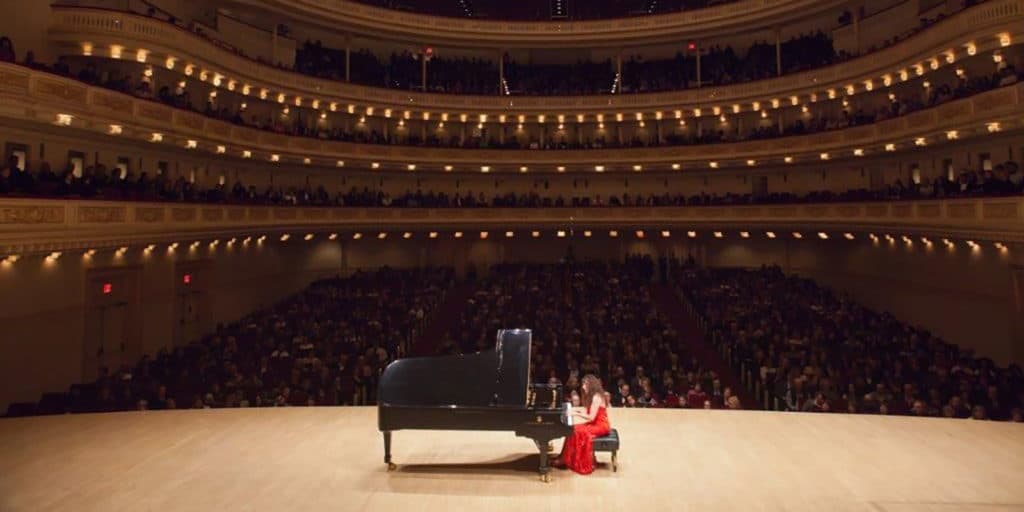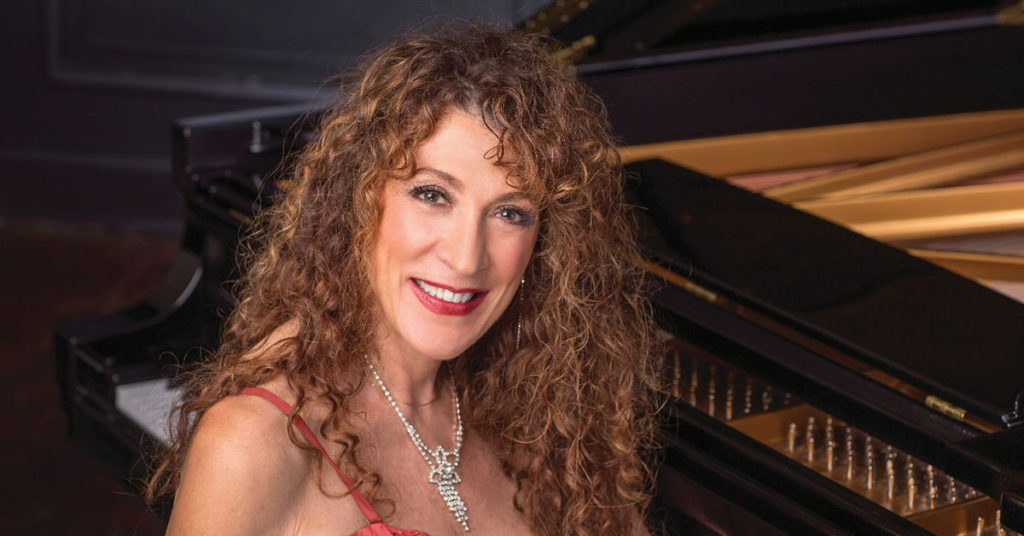Rosa Antonelli is a world-renowned New York concert pianist, originally from Argentina. She is one of the most famous Argentine pianists.
Watch Party for Piazzolla’s Birthday
Celebrate Astor Piazzolla’s birthday and remember the lives lost to the COVID-19 Pandemic with a streaming presentation of Antonelli’s Lincoln Center concert on YouTube on Friday, March 12, 2021 at 7:30pm. FREE
Part 2 of this online watch party is on YouTube on Wednesday, March 31, 2021 at 7:30pm. FREE
Sponsored by the Argentine Consulate in New York.
Consulate of Argentina Watch Party

Rosa Antonelli and the New York Consulate of Argentina host an online watch party of Antonelli’s now legendary sold-out 2011 performance at Carnegie Hall on Antonelli’s YouTube channel on Monday, August 10, 2020 at 7:30pm. Free
Part 2 is Thursday, September 17, 2020 at 7:30pm. Free
Ms. Antonelli will perform “L’Automne Waltz” and “Granada” from “Suite Española” by Albeniz, the World Premieres of two works by Piazzolla, “El Mundo de los dos” and
“Imperial,” Ginastera’s “Tres Danzas Argentinas” and a special encore.
Do You Know the Way to Carnegie Hall?
by Keith Widyolar
August 6, 2020
We first met Rosa Antonelli in New York when she started practicing for her now legendary sold-out recital at Carnegie Hall’s Stern Auditorium in 2011. [Was it that long ago? We still remember it like yesterday.]
Even child prodigy master artists practice for a year before they play Carnegie Hall. It’s the truth to the old saying, “Do you know the way to Carnegie Hall? Practice, Practice, Practice.”
Even if you are not a classical music fan, listening to Antonelli play the piano makes you forget your entire world, blink your eyes in wonder at what you are hearing, and afterwards, all you can say is, “Wow!”
She’s a Steinway Artist and somehow she puts a spell on you through that piano. We need performances like this now.
Chopin and the Music of a Skipping Heart
Argentines are famously emotional and Antonelli loves Chopin, the iconic piano composer of the Romantic Era (roughly 1800s to early 1900s) . He composed during a time of rapid change in society when the Industrial Revolution put people to work in the most dreadful manner. Lives became so dreary and repetitive that people dreamed of a romanticized past.
That sounds a bit like now, as we are swimming, foundering through the first wave of the COVID-19 Coronavirus Pandemic.
Chopin and other Romantic artists started bending the rules of the Classical Era that preceded them. Among other things, he uses a lot of rubato meaning some of Chopin’s notes fall just before or after the beat (like bossa nova, hip-hop and reggaeton actually). You can’t just play Chopin by reading the sheet music. You have to feel him. If you want your listeners to feel what you feel, you have to open your soul a lot.
Chopin’s music takes you on a journey that can be a bit like walking around New York City. One block is serene, then you turn a corner and suddenly its intense and the street is screaming at you. You cross the avenue and it turns soft and quiet again. You take a deep breath and go on your way.
From Chopin to Ginastera
Antonelli draws a direct line from Chopin to legendary Argentine composers Alberto Ginastera (1916-1983) and Astor Piazzolla (1921-1992).
Ginastera is one of the most important classical composers of the Americas. In the manner of his time, he made compositions based on the folk music of Argentina and Latin America.
Piazzolla, who actually got his first bandoneón in New York City, created the form of classical tango jazz known as “tango nuevo” (new tango).
From Ginastera to Oblivion
To be a master of classical music, you have to study with a master. The proverbial baton is passed from one hand to the next. There is no other way. Antonelli says that Chopin reached Piazzolla through five generations of teachers. Piazzolla’s first music teacher (in NYC’s Little Italy) was Hungarian classical pianist Bela Wilda, a student of Rachmaninoff. She taught Astor to play Bach on his bandoneón.
In 1939 in Argentina, Piazzolla found work in Aníbal Troilo’s tango orchestra. Troilo is one of the bandoneón-playing giants of tango. Piazzolla became Troilo’s arranger.
Foreigners think of tango as distinctly Argentine and it is, but it hasn’t always been fully accepted by Argentine society. It started in bordellos when those were the biggest businesses in Argentina (because of male-only immigration,) and was considered a very low-class music.
Even in New York today, an Argentine hair stylist who ran the beauty salon at Saks Fifth Avenue once looked me in the eye and said, “if you take my sister to tango, I will kill you.” So there is this strange push-pull tension between tango and high society. High society loves the profound freedom of tango, but looks down on you for it.
Dreaming of being a classical composer. Arthur Rubinstein advised Piazzolla to study with Ginastera which he did for many years and he learned orchestration. After watching his student for years, Ginastera understood the young man well and finally encouraged him to write his own tango.
The rest is history. Piazzolla dreamed of making tango classy and he achieved that. When Argentines first heard this new tango in 1955, they said it wasn’t tango, but now it is the dominant form.
Antonelli is right. There is a perfect connection between the Romanticism of Chopin and Piazzolla through Ginastera, through Buenos Aires and New York.
To Oblivion and Back
One of the most haunting pieces of music ever written or played is Piazzolla’s “Oblivion.” I first really listened to it once upon a time in Istanbul at a tango festival on the shores of the Bosphorus. My friend Ortaç played the bandoneón and Utku played the guitar. I was scouting photo angles for a shoot during the dance that night, but “Oblivion” stopped me cold. I forgot about what I was doing, blinked my eyes and said to myself, “Wow!”
The music haunts me even now. If you want to know what we are all so afraid of in this first wave of the COVID-19 Coronavirus Pandemic, it’s all there in Piazzolla’s “Oblivion.”
At this scary moment in time, looking the abyss straight in the eyes may be just the therapy you need to know that no matter what happens, things will be all right.
Listen to Rosa Antonelli play Chopin, Ginastera and Piazzolla. She will make you remember things you didn’t even know you knew.
Piazzolla wrote “Adios Nonino” after a great loss. “Nonino” was his grandfather.
Rosa Antonelli

New York-based, Argentinian pianist Rosa Antonelli, a Steinway Artist since 1998, is one of today’s leading performers and a champion of classical Latin-American and Spanish music.
She has toured extensively, with more than 1,000 concerts in Europe, Africa, Asia, Latin America and North America, and is dedicated to performing and recording the works of that include Argentinian composers Piazzolla, Ugarte, Gianneo and Guastavino, as well as Albeniz, Granados, Villa -Lobos, Ponce and many others from Spain and Latin America, and bringing them to audiences all over the world.
